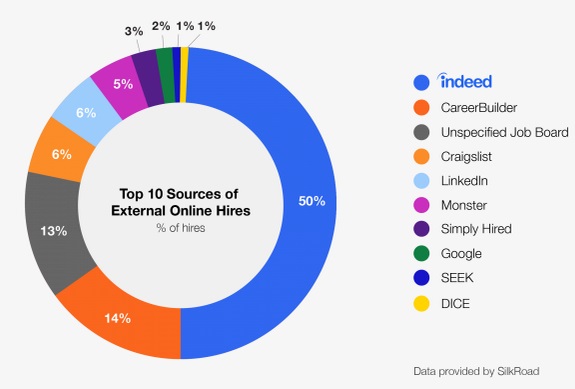Silkroad recently released some results from it’s annual client survey (also released by Indeed as you can imagine from the results!), which is a rather large sample. The chart that caught my eye was this one:
Keep in mind these are external online sources only. These don’t include an companies own career site, employee referrals, etc. Still the information is intriguing, and almost matches my own internal numbers for my company, which means I tend to believe the data!
Indeed being number one as a source for corporate hires isn’t not surprising. If a candidate is looking for a job today, they go to Indeed to start looking. What is surprising is the LinkedIn number!
6% of external online hires are coming from LinkedIn!
So, you need to ask yourself: How much money are you spending on LinkedIn as compared to the other sources that are getting greater results? Indeed, CareerBuilder, other various specialized job boards, etc.
Would have ever thought that LinkedIn would have been the exact same percentage as Craigslist!?!
Obviously, the candidates you are getting on LinkedIn are different than the candidates you’re getting on Craigslist. Not many professionals are looking for jobs on Craigslist, but you will find a ton looking for lower skilled, service level jobs.
Based on the data above here’s what you need to do:
1. Are your jobs being scraped by Indeed? Have you checked? If not, you better make this happen! (Same for SimplyHired)
2. Are you using CareerBuilder? Postings? Resume database? Might want to check into what they’ve got going on!
3. If you have a LinkedIn Recruiter seat, are you getting a good ROI for your investment? Would you get a better ROI is that same amount of money was spent for things like sponsored jobs on Indeed, or most job posts on CareerBuilder? Maybe you need to do some testing.
4. Are you using Craigslist to help fill your lower level positions? You know it’s free, right?
5. What the hell is Seek? Oh, it’s a job board in Australia, you can forget about that.
6. Don’t forget about your other non-online sources: Referrals, your own career site, local state employment offices, alumni, your own internal database (this is the most under utilized source of most companies!), etc. These probably fill more than all your online sources. How much money are you investing in them? (it’s usually a lot less than online sources and a huge miss for ROI)

